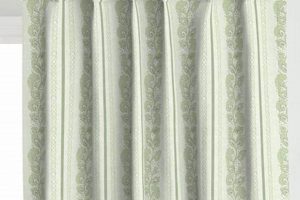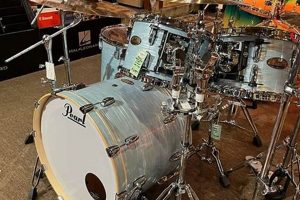The enterprise, active from the late 19th century through the early 20th century, produced decorative arts renowned for innovative designs and meticulous craftsmanship. Its output encompassed leaded glass lamps, windows, mosaics, pottery, and metalwork. These creations are characterized by vibrant colors achieved through the use of opalescent glass and sophisticated techniques. The Dragonfly lamp, featuring intricate representations of dragonflies with colored glass wings, exemplifies its distinctive aesthetic.
The products from this entity held significant cultural importance, reflecting the Art Nouveau movement and influencing American design. Its creations were highly sought after by affluent patrons and institutions. The techniques developed and employed remain influential in glass art and design practices. The historical context provides insight into the evolution of American decorative arts and the pursuit of artistic innovation in industrial production.
The following sections will delve further into specific aspects of the organization, its techniques, the impact of its creations, and the current valuation and preservation efforts surrounding these historically significant artifacts.
Tips for Identifying Authentic Examples
Proper identification requires careful consideration of several key factors. Determining authenticity requires a multi-faceted approach and is crucial for collectors and enthusiasts.
Tip 1: Examine the Glass Quality. Original articles utilize opalescent glass, characterized by its varied colors and textures. The glass often appears to have depth and complexity, exhibiting subtle color variations within a single piece. Reproduction pieces frequently lack this nuanced quality.
Tip 2: Analyze the Lead Came Construction. The lead came used in original pieces is typically meticulously soldered and finished. The lines should be clean and consistent, with no signs of sloppy workmanship. The patina on the lead is also a key indicator of age and authenticity.
Tip 3: Inspect the Metalwork and Bases. The metalwork, often bronze, exhibits a rich patina and detailed craftsmanship. The bases of lamps and other items were often signed or stamped with the company’s mark. However, the absence of a mark does not automatically indicate inauthenticity, as some pieces were unmarked.
Tip 4: Evaluate the Design and Motif. The designs often feature naturalistic motifs such as flowers, insects, and landscapes. These designs are rendered with a high degree of artistic skill and attention to detail. Familiarity with the company’s signature designs is essential for identification.
Tip 5: Check for the Presence of Favrile Glass. Favrile glass, a proprietary type of iridescent art glass, is frequently found in authentic pieces. The iridescent surface of Favrile glass exhibits a shimmering, metallic effect, which is difficult to replicate convincingly.
Tip 6: Seek Expert Opinion. Consultation with a qualified appraiser or specialist is recommended for high-value or questionable items. Professional appraisers possess the knowledge and experience necessary to accurately assess authenticity and value.
Accurate assessment of these factors contributes significantly to the verification process, protecting buyers from fraudulent representations and preserving the value of genuine artifacts.
The following sections will address conservation and preservation techniques, ensuring the longevity of these important artistic legacies.
1. Opalescent Glass Innovation
Opalescent glass innovation was a foundational component of the entity’s distinctive artistry. This type of glass, characterized by its milky, iridescent appearance and varied light transmission properties, enabled unprecedented effects. The experimentation with chemical compositions and firing processes resulted in glass sheets displaying internal color variations and surface textures previously unattainable. This innovation was not merely aesthetic; it fundamentally altered the way light interacted with the crafted objects. For example, the depiction of foliage in leaded glass windows relied heavily on opalescent glass to create realistic depth and shadow, effectively simulating the natural world.
The impact of this material extended beyond visual appeal. Opalescent glass facilitated the creation of “painterly” effects within the medium of glass. Artisans could blend colors within the glass itself, rather than relying solely on the lead lines to define boundaries. The Wisteria lamp, a prominent example, demonstrates this capability, its cascading flowers exhibiting subtle gradations of color achieved through the careful layering of opalescent glass pieces. The development and application of proprietary glass formulations, such as Favrile glass, further advanced these artistic possibilities. These advancements in glass production were critical to the aesthetic originality.
In summary, the integration of opalescent glass was a catalyst for artistic experimentation within the organization. The mastery of opalescent glass was not merely a technical achievement, but a transformative element that defined its unique visual language and established its reputation. Understanding this connection is crucial for appreciating the aesthetic and historical significance of its products and for discerning authentic creations from later imitations. This innovation remains a hallmark of its artistic achievements.
2. Intricate Leaded Designs
Intricate leaded designs are inextricably linked to the artistic identity of the enterprise, functioning as a defining characteristic of its output. The complexity of the leaded designs was not merely ornamental; it was integral to translating artistic vision into tangible form. Leaded glass construction allowed the creation of detailed imagery, impossible to achieve with solid sheets of glass. The lead lines, while structurally necessary, also served as an artistic element, defining outlines and contributing to the overall aesthetic. The meticulous arrangement of individual pieces of colored and textured glass within the lead matrix enabled the creation of complex patterns, floral motifs, and pictorial scenes. The Wisteria transoms, for example, feature thousands of individual glass pieces, each carefully selected and positioned to replicate the delicate beauty of the natural world. The precise execution of these intricate leaded designs directly influenced the perceived value and artistic merit.
The process of creating these intricate designs demanded considerable skill and craftsmanship. Artisans had to meticulously cut, shape, and solder each piece of glass, ensuring a precise fit within the lead came framework. The lead came itself had to be carefully manipulated to conform to the complex contours of the design. The success of the entire composition depended on the accurate execution of each individual step. The “Autumn Landscape” window demonstrates the mastery of this technique, showcasing a panoramic scene rendered with exceptional detail through the strategic use of lead lines and carefully chosen glass colors. The preservation of these designs is paramount as they represent a unique fusion of artistic vision and technical expertise.
In conclusion, the intricate leaded designs constitute a fundamental element of the organization’s artistic legacy. These designs are not simply decorative embellishments; they are integral to the expression of artistic ideas and the demonstration of technical skill. The capacity to appreciate the intricacies of these designs provides a deeper understanding of the historical and artistic value. These considerations are vital for authenticating, preserving, and interpreting the creations.
3. Favrile Glass Techniques
Favrile glass techniques represent a pivotal innovation, fundamentally intertwined with the aesthetic achievements of the studio. This proprietary form of iridescent art glass significantly enhanced the organization’s capacity for artistic expression. Its development and application are hallmarks of their unique style, influencing the broader landscape of decorative arts.
- Iridescent Surface Creation
Favrile glass derives its defining characteristic from metallic salts applied to the molten glass during the production process. Subsequent reheating and manipulation create a shimmering, iridescent surface. The exact composition of the metallic salts and the firing temperatures were closely guarded secrets, contributing to the glass’s unique qualities. An example is the peacock feather motif often found in lamps and vases, where the iridescent surface enhances the visual richness and depth of the design. The control and mastery of this process directly impacted the perceived value of each finished item.
- Color Manipulation and Blending
The Favrile process permitted unprecedented control over color within the glass itself. By layering different metallic salts and manipulating the molten glass, artisans could achieve complex color gradients and subtle shifts in hue. This facilitated the creation of naturalistic representations, such as the depiction of flowers with varying shades of color within each petal. The “Jack-in-the-Pulpit” vases showcase the subtle color blends achievable with Favrile glass. These advancements allowed for a more nuanced and expressive artistic vocabulary.
- Textural Variations
Favrile glass was not limited to smooth, polished surfaces. Artisans also employed techniques to create a variety of textures, ranging from subtly rippled effects to pronounced ridges and dimples. These textures enhanced the visual and tactile appeal of the glass, adding another layer of complexity to the designs. The textured surfaces often simulated natural elements, such as water or foliage, further blurring the line between art and nature. The incorporation of textural variations expanded the creative possibilities and demonstrated a commitment to innovative design.
- Application in Diverse Forms
Favrile glass was used in a wide range of forms, including lampshades, vases, windows, and mosaics. Its versatility allowed it to be integrated into diverse artistic creations. The leaded glass windows, in particular, benefited from the integration of Favrile glass, adding a luminous quality and enhancing the overall visual impact. The integration of Favrile glass across diverse forms underscores its pervasive influence on the organization’s artistic output and demonstrates its adaptability as a medium.
The strategic use of Favrile glass techniques defined its aesthetic identity and distinguished its creations from its contemporaries. The technical expertise and artistic vision demonstrated in the creation and application of Favrile glass remain a testament to innovation and enduring artistic legacy. The integration of this medium across diverse forms and applications solidifies its significance as a defining feature of the studio’s artistic output.
4. Art Nouveau Influence
The entity’s aesthetic is deeply rooted in the Art Nouveau movement, demonstrably influencing its design principles and production philosophies. Art Nouveau, with its emphasis on organic forms, flowing lines, and natural motifs, directly shaped the studio’s signature style. The movement’s focus on integrating art into everyday objects aligned perfectly with its mission to create aesthetically pleasing and functional pieces for the home. The pervasive use of floral patterns, insect motifs, and curvilinear designs in leaded glass lamps, windows, and other decorative items exemplifies this influence. Without Art Nouveau, the studios aesthetic would not be recognizable or important as cultural legacy. The Wisteria Lamp directly embodies the link, translating sinuous natural form into luxurious art object.
Art Nouveau advocated for a holistic approach to design, blurring the boundaries between fine art and craft. This philosophy is evident in the careful attention to detail and the high level of craftsmanship evident in all products. The emphasis on handcrafted elements, even in mass-produced items, reflects the Art Nouveau ideal of elevating the everyday through artistic intervention. The application of the Favrile glass technique, allowing for the creation of iridescent surfaces and intricate color blends, further amplified the Art Nouveau aesthetic, adding an element of visual richness and complexity. The Dragonfly lamp demonstrated this aesthetic, marrying detailed craftsmanship and materials.
Understanding the Art Nouveau influence is critical for interpreting and appreciating the studio’s contributions to the decorative arts. It provides context for the stylistic choices, the material experimentation, and the underlying philosophy that shaped its creations. It also aids in the authentication process, enabling collectors and enthusiasts to distinguish authentic pieces from later imitations. Recognizing this connection helps facilitate the preservation of these artifacts, safeguarding their value and ensuring their continued appreciation as symbols of the Art Nouveau era and the organization that embodied its principles.
5. Iconic Lamp Creations
The iconic lamp creations constitute a cornerstone of the artistic legacy. These lamps, renowned for their intricate designs and innovative use of colored glass, are not merely decorative objects but rather quintessential representations of the studio’s design philosophy and technical expertise. The production of these iconic lamps served as a primary driver of the enterprise’s success and significantly contributed to its enduring reputation. The lamps exemplify the studio’s commitment to craftsmanship and artistic innovation. Real-life examples, such as the Wisteria lamp and the Dragonfly lamp, demonstrate the intricate leaded glass techniques and the sophisticated use of opalescent glass that are hallmarks of the organization’s style. Understanding the design and construction of these iconic lamps provides insight into the aesthetic and practical considerations that guided the studio’s creative process.
The enduring popularity of the iconic lamps has a cascading effect, influencing the market valuation, historical preservation efforts, and scholarly appreciation. The lamps, being readily identifiable and culturally significant, are highly sought after by collectors and museums. The market value reflects both their artistic merit and historical significance. Their prominent position in the art world fuels preservation efforts, ensuring their continued accessibility for future generations. The lamps act as a focal point for scholars studying the Art Nouveau movement and the history of American decorative arts. Therefore, analyzing these products delivers tangible insights into the organization’s multifaceted impact.
In summary, the iconic lamp creations are more than just products; they encapsulate the artistic vision, technical prowess, and cultural significance of the enterprise. Their importance stems from their function as both artistic masterpieces and historical artifacts. Understanding their design, production, and market impact is crucial for fully appreciating legacy. The challenge lies in ensuring their continued preservation and accessibility for future generations, allowing for a deeper engagement with American art history.
Frequently Asked Questions About Tiffany Studio
This section addresses commonly encountered inquiries regarding this entity, providing accurate information to clarify uncertainties surrounding its history, products, and authentication.
Question 1: What time period did Tiffany Studio operate within?
The organization operated primarily from the late 19th century through the early 20th century, reaching its peak during the Art Nouveau era.
Question 2: What types of products were typically produced by Tiffany Studio?
Production encompassed a wide array of decorative arts, including leaded glass lamps, windows, mosaics, pottery, and metalwork.
Question 3: What is Favrile glass, and why is it significant?
Favrile glass is a proprietary form of iridescent art glass developed by this entity. Its significance lies in its unique visual properties and its contribution to the distinctive style of the studio’s creations.
Question 4: How can one distinguish an authentic piece from a reproduction?
Authenticity can be assessed by examining the quality of the glass, the construction of the lead came, the presence of Favrile glass, and the overall design and motif. Expert appraisal is recommended for confirmation.
Question 5: What is the typical range of valuation for an original lamp?
The valuation of an original lamp varies significantly depending on its design, size, condition, and provenance. Prices can range from several thousand to millions of dollars.
Question 6: How should items be properly cared for and preserved?
Preservation requires careful handling, protection from direct sunlight, and regular cleaning with non-abrasive materials. Professional conservation services may be necessary for damaged or deteriorating items.
Understanding these answers clarifies common misconceptions, fostering a more informed appreciation for creations.
The subsequent sections will provide information regarding contemporary valuation and investment considerations within this field.
Conclusion
This exploration has traversed the multifaceted aspects of tiffany studio, from its innovative techniques in glassmaking to its enduring influence on decorative arts. Key aspects discussed include the significance of opalescent glass, the intricacies of leaded designs, the proprietary Favrile glass process, the pervasive influence of Art Nouveau, and the cultural impact of its iconic lamp creations. Understanding these core elements enables a more informed appreciation of its contributions to American art history. Further, practical guidance on authentication and preservation helps ensure responsible stewardship of its invaluable legacy.
The continuing interest in tiffany studio underscores its timeless appeal and historical importance. Continued research and dedicated conservation efforts are vital in safeguarding these cultural artifacts for future generations. The legacy serves as a reminder of the transformative power of art, design, and technical innovation, inspiring continued appreciation and study within the broader context of art history and material culture. Therefore, safeguarding and studying such a legacy is important.







